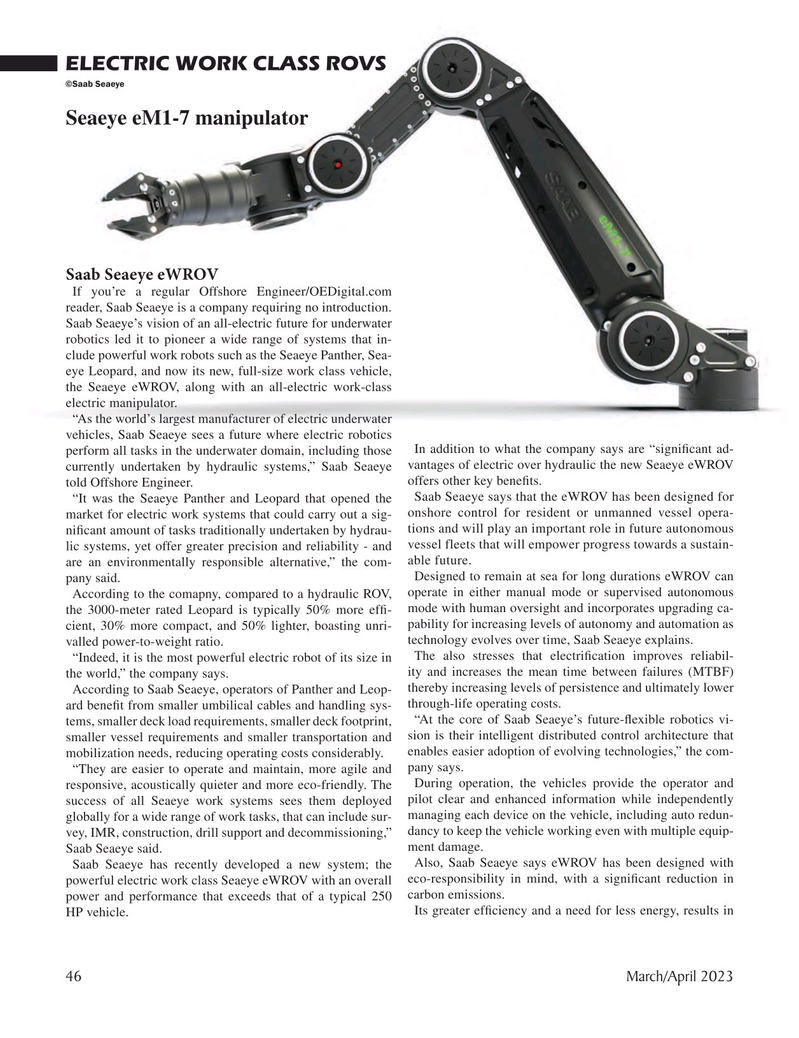
Page 46: of Marine Technology Magazine (March 2023)
Read this page in Pdf, Flash or Html5 edition of March 2023 Marine Technology Magazine
ELECTRIC WORK CLASS ROVS ©Saab Seaeye
Seaeye eM1-7 manipulator
Saab Seaeye eWROV
If you’re a regular Offshore Engineer/OEDigital.com reader, Saab Seaeye is a company requiring no introduction.
Saab Seaeye’s vision of an all-electric future for underwater robotics led it to pioneer a wide range of systems that in- clude powerful work robots such as the Seaeye Panther, Sea- eye Leopard, and now its new, full-size work class vehicle, the Seaeye eWROV, along with an all-electric work-class electric manipulator.
“As the world’s largest manufacturer of electric underwater vehicles, Saab Seaeye sees a future where electric robotics
In addition to what the company says are “signi? cant ad- perform all tasks in the underwater domain, including those currently undertaken by hydraulic systems,” Saab Seaeye vantages of electric over hydraulic the new Seaeye eWROV offers other key bene? ts.
told Offshore Engineer.
Saab Seaeye says that the eWROV has been designed for “It was the Seaeye Panther and Leopard that opened the onshore control for resident or unmanned vessel opera- market for electric work systems that could carry out a sig- tions and will play an important role in future autonomous ni? cant amount of tasks traditionally undertaken by hydrau- lic systems, yet offer greater precision and reliability - and vessel fleets that will empower progress towards a sustain- able future.
are an environmentally responsible alternative,” the com-
Designed to remain at sea for long durations eWROV can pany said.
According to the comapny, compared to a hydraulic ROV, operate in either manual mode or supervised autonomous mode with human oversight and incorporates upgrading ca- the 3000-meter rated Leopard is typically 50% more ef? - pability for increasing levels of autonomy and automation as cient, 30% more compact, and 50% lighter, boasting unri- technology evolves over time, Saab Seaeye explains.
valled power-to-weight ratio.
The also stresses that electri? cation improves reliabil- “Indeed, it is the most powerful electric robot of its size in ity and increases the mean time between failures (MTBF) the world,” the company says.
thereby increasing levels of persistence and ultimately lower
According to Saab Seaeye, operators of Panther and Leop- through-life operating costs.
ard bene? t from smaller umbilical cables and handling sys- “At the core of Saab Seaeye’s future-? exible robotics vi- tems, smaller deck load requirements, smaller deck footprint, smaller vessel requirements and smaller transportation and sion is their intelligent distributed control architecture that enables easier adoption of evolving technologies,” the com- mobilization needs, reducing operating costs considerably.
“They are easier to operate and maintain, more agile and pany says.
During operation, the vehicles provide the operator and responsive, acoustically quieter and more eco-friendly. The success of all Seaeye work systems sees them deployed pilot clear and enhanced information while independently managing each device on the vehicle, including auto redun- globally for a wide range of work tasks, that can include sur- vey, IMR, construction, drill support and decommissioning,” dancy to keep the vehicle working even with multiple equip- ment damage.
Saab Seaeye said.
Also, Saab Seaeye says eWROV has been designed with
Saab Seaeye has recently developed a new system; the powerful electric work class Seaeye eWROV with an overall eco-responsibility in mind, with a signi? cant reduction in power and performance that exceeds that of a typical 250 carbon emissions.
Its greater ef? ciency and a need for less energy, results in
HP vehicle.
46 March/April 2023
MTR #3 (34-49).indd 46 3/20/2023 12:45:46 AM

 45
45

 47
47
